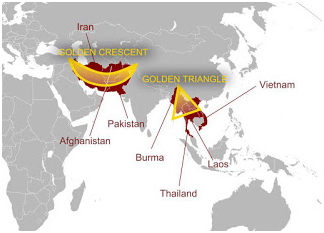Social Justice
Fighting Drug Menace
- 22 Jul 2021
- 7 min read
Why in News
India has signed 26 bilateral pacts, 15 memoranda of understanding and two agreements on security cooperation with different countries for combating illicit trafficking of narcotic, drugs and psychotropic substances, besides chemical precursors.
Key Points
- Drug Menace In India:
- The menace of drug addiction has spread fast among the youth of India.
- India is sandwiched between two largest Opium producing regions of the world that is the Golden triangle on one side and the Golden crescent on other.

- The golden triangle area comprises Thailand, Myanmar, Vietnam and Laos.
- The golden crescent area includes Pakistan, Afghanistan and Iran.
- India is sandwiched between two largest Opium producing regions of the world that is the Golden triangle on one side and the Golden crescent on other.
- According to the World Drug Report 2021, prescription drugs and their ingredients or 'precursors' are being increasingly diverted for recreational use in India--the largest manufacturer of generic drugs in the world.
- India is also linked to shipment of drugs sold on the 19 major darknet markets analysed over 2011-2020.
- As per the report Magnitude of Substance Use in India released by All India Institute Of Medical Science (AIIMS) in 2019:
- Around 5 crore Indians reported to have used cannabis and opioids at the time of the survey (conducted in the year 2018).
- It has been estimated that there are about 8.5 lakh people who inject drugs.
- Of the total cases estimated by the report, more than half of them are contributed by states like Punjab, Assam, Delhi, Haryana, Manipur, Mizoram, Sikkim and Uttar Pradesh.
- About 60 lakh people are estimated to need help for their opioid use problems.
- The menace of drug addiction has spread fast among the youth of India.
- Various Steps taken:
- Coordination with Various International Organisations:
- The Narcotics Control Bureau (NCB) coordinated with various international organisations for sharing information and intelligence to combat transnational drug trafficking.
- They included the SAARC, BRICS, Colombo Plan, ASEAN, BIMSTEC, United Nations Office on Drugs and Crime, and the International Narcotics Control Board.
- Coordination among Various Central and State Agencies:
- For this, the Narco Coordination Centre (NCORD) mechanism was set up by the Ministry of Home Affairs (MHA) in 2016 for effective drug law enforcement.
- This NCORD system was restructured into a four-tier scheme up to district level in July 2019, for better coordination.
- A Joint Coordination Committee with the NCB Director General as its chairman was set up in July 2019, to monitor the investigation into cases involving large seizures.
- For this, the Narco Coordination Centre (NCORD) mechanism was set up by the Ministry of Home Affairs (MHA) in 2016 for effective drug law enforcement.
- SIMS (Seizure Information Management System) Portal:
- For digitisation of pan-India drug seizure data, the MHA launched an e-portal called ‘SIMS’ in 2019 for all the drug law enforcement agencies under the mandate of Narcotics Drugs and Psychotropic Substances Act (NDPS).
- National Fund for Control of Drug Abuse:
- It was constituted to meet the expenditure incurred in connection with combating illicit traffic in Narcotic Drugs; rehabilitating addicts, and educating the public against drug abuse, etc.
- National Drug Abuse Survey:
- The government is also conducting the Survey to measure trends of drug abuse in India through the Ministry of Social Justice & Empowerment with the help of National Drug Dependence Treatment Centre of AIIMS.
- Project Sunrise:
- It was launched by the Ministry of Health and Family Welfare in 2016, to tackle the rising HIV prevalence in north-eastern states in India, especially among people injecting drugs.
- The Narcotic Drugs and Psychotropic Substances Act, (NDPS) 1985:
- It prohibits a person from producing, possessing, selling, purchasing, transporting, storing, and/or consuming any narcotic drug or psychotropic substance.
- The NDPS Act has since been amended thrice – in 1988, 2001 and 2014.
- The Act extends to the whole of India and it applies also to all Indian citizens outside India and to all persons on ships and aircraft registered in India.
- ‘Nasha Mukt Bharat’, or Drug-Free India Campaign:
- It focuses on community outreach programs.
- Coordination with Various International Organisations:
- International Treaties and Conventions to Combat Drug Menace:
- India is signatory of the following International treaties and conventions to combat the menace of Drug Abuse:
- United Nations (UN) Convention on Narcotic Drugs (1961)
- UN Convention on Psychotropic Substances (1971).
- UN Convention against Illicit Traffic in Narcotic Drugs and Psychotropic Substances (1988)
- UN Convention against Transnational Organized Crime (UNTOC) 2000
- India is signatory of the following International treaties and conventions to combat the menace of Drug Abuse:
Way Forward
- While steps must be taken to stop supply by tamping down on cross-border trafficking, imposing harsher penalties under the NDPS Act, or improving drug enforcement, India must also address the problem on the demand side.
- Addiction should not be seen as a character flaw, but as an ailment that any other person could be struggling with. Therefore, the stigma associated with drug taking needs to be reduced. Society needs to understand that drug-addicts are victims and not criminals.
- Certain crop drugs which have more than 50% alcohol and opioids need to be contained. Strict action is required from police officers and the excise and narcotics department to curb the problem of drug menace in the country.
- Education curriculum should include chapters on drug addiction, its impact and also on de-addiction. Proper Counselling is another alternative.






